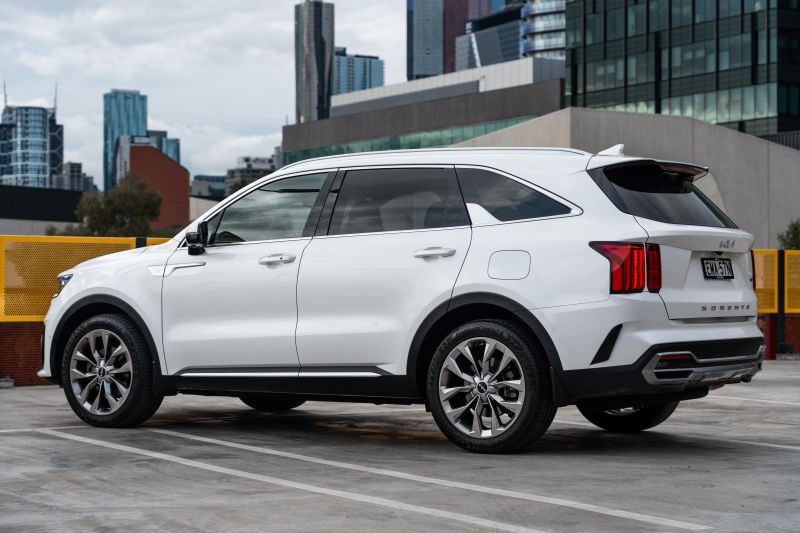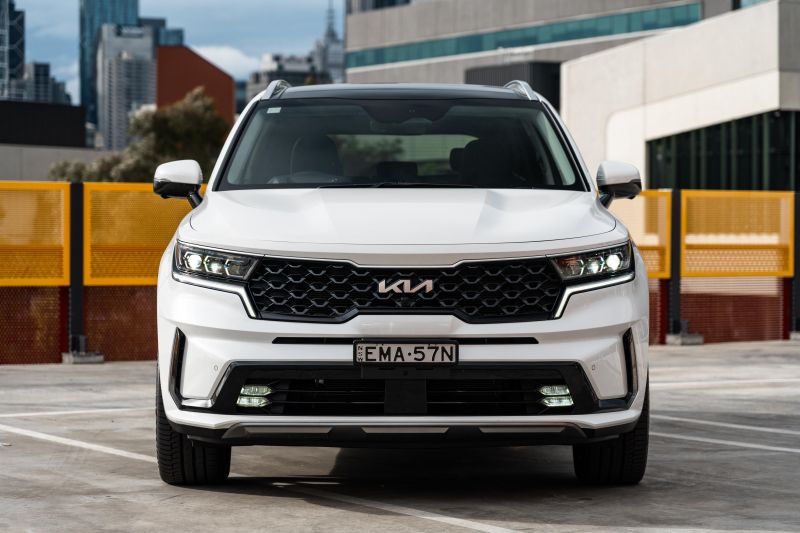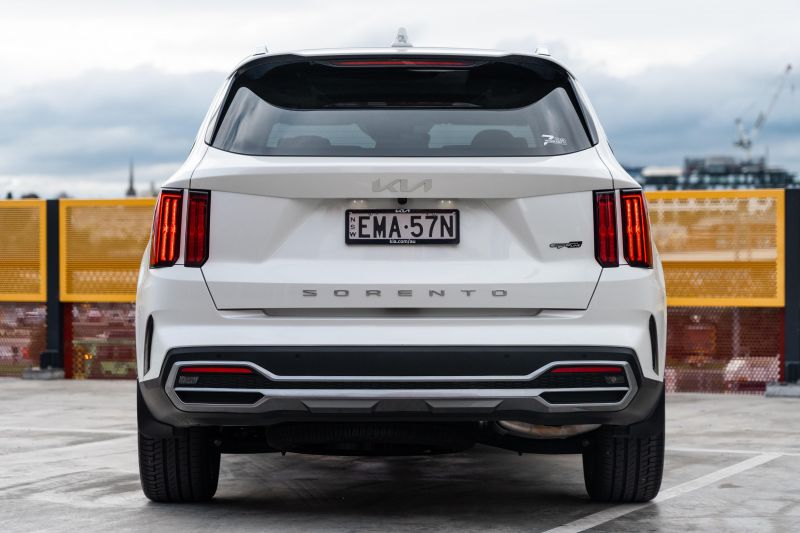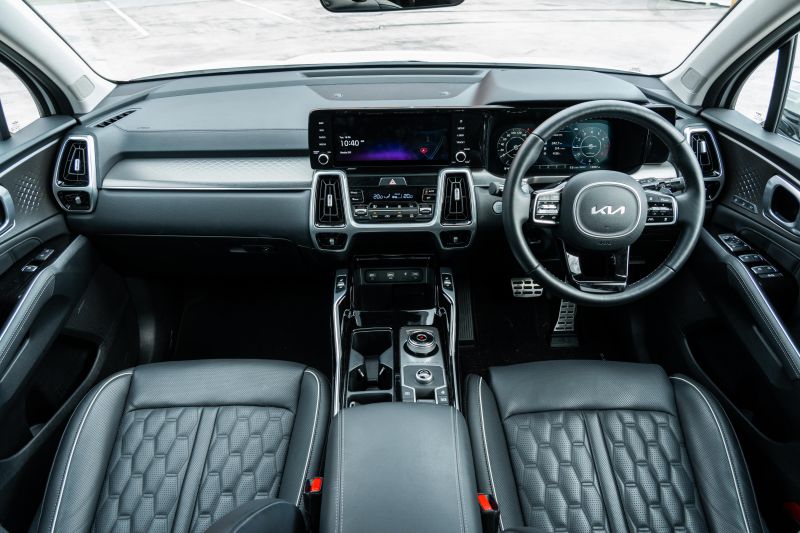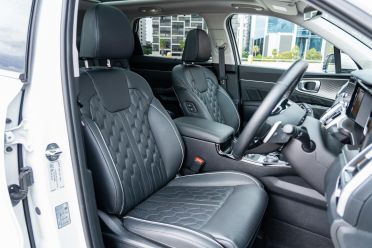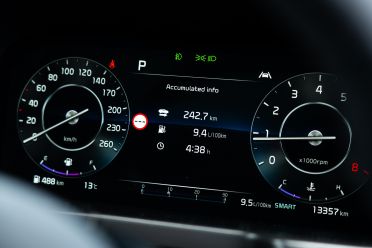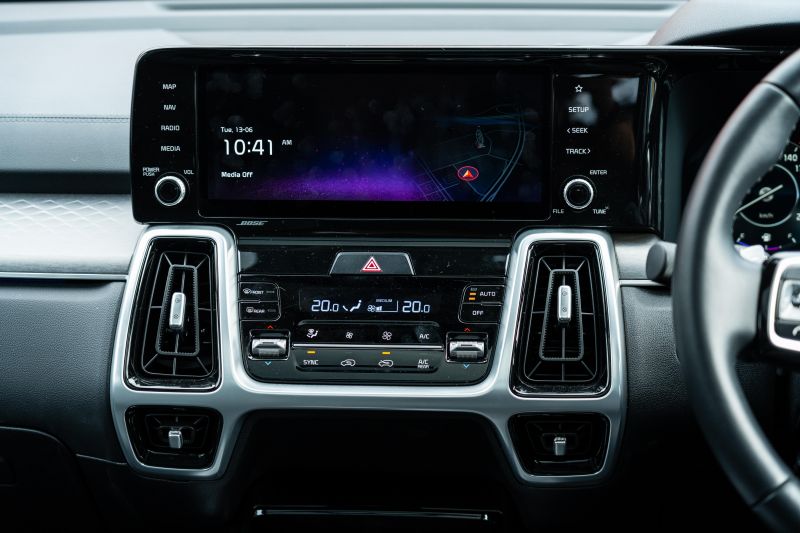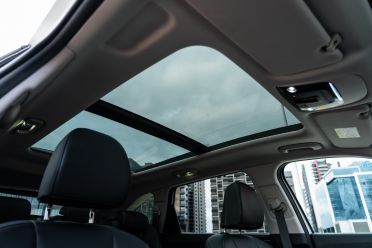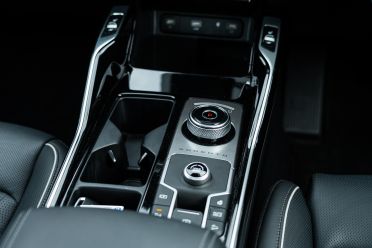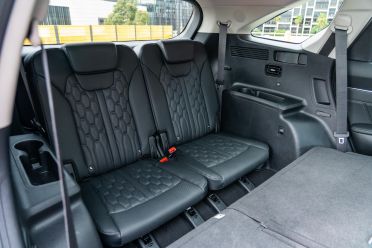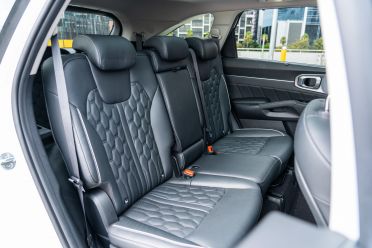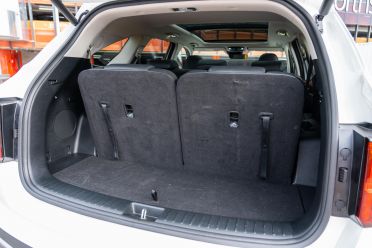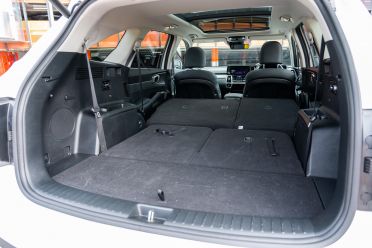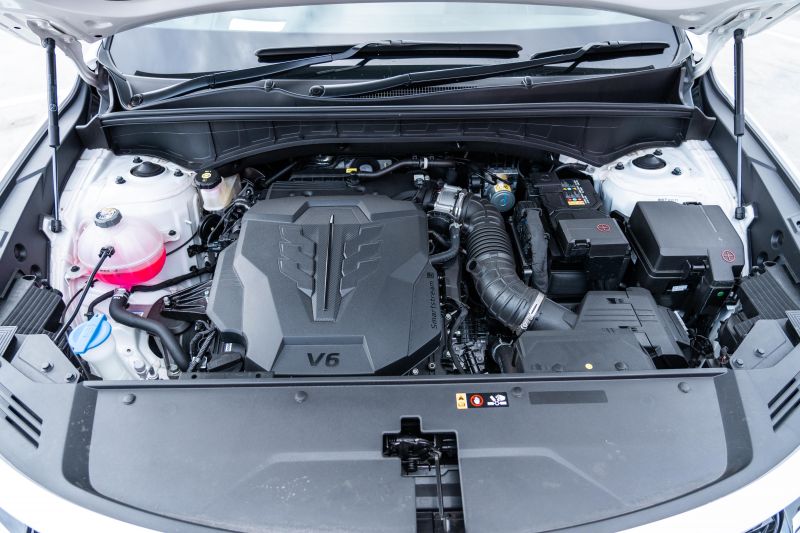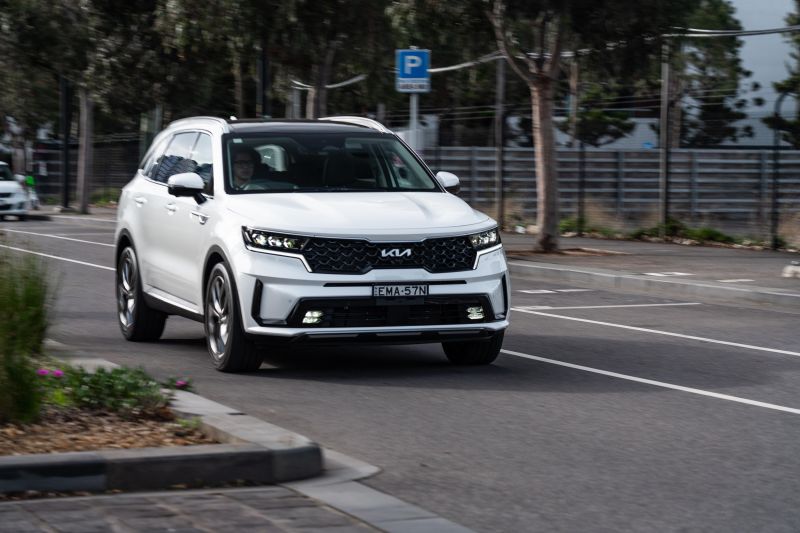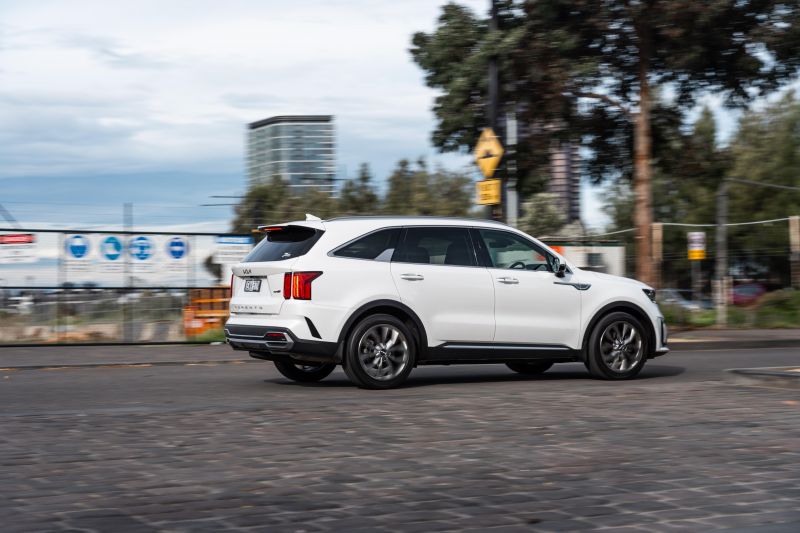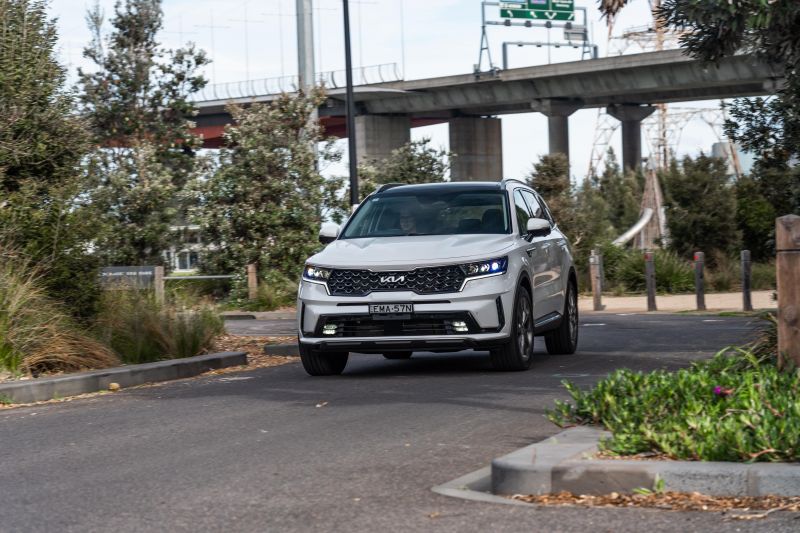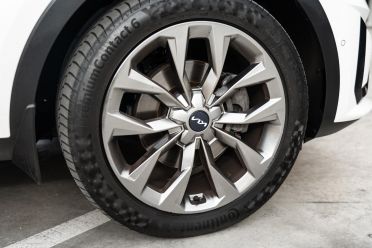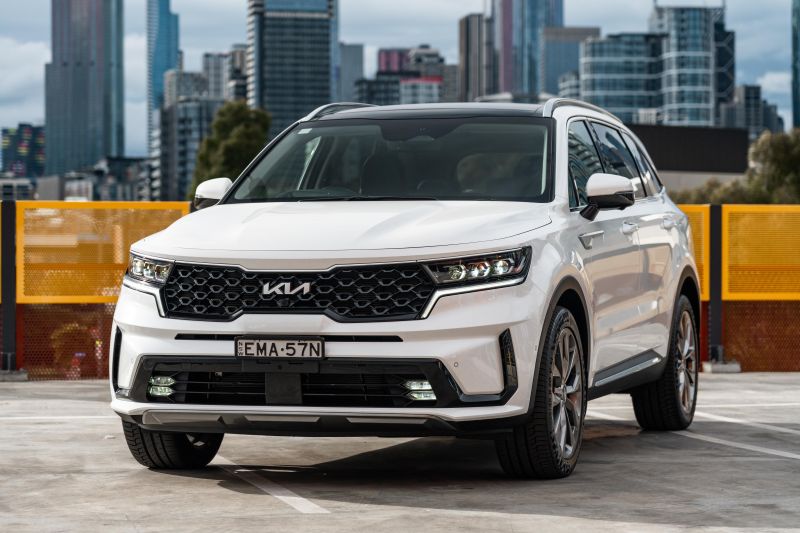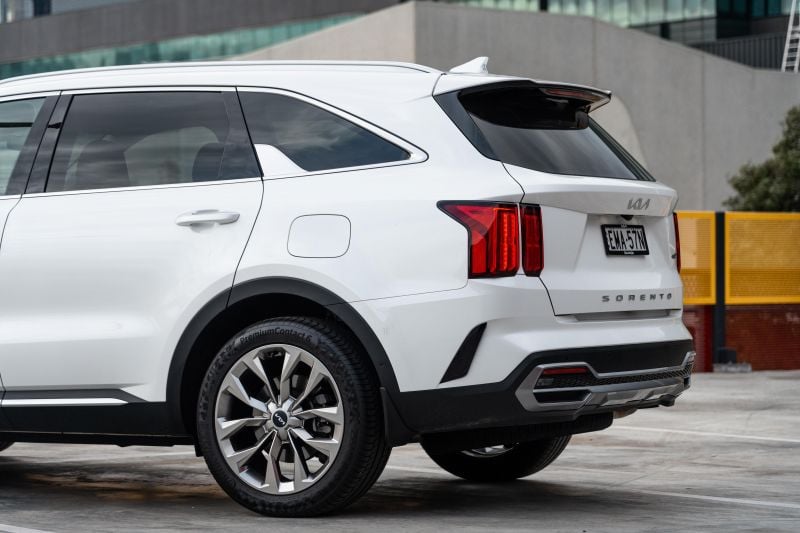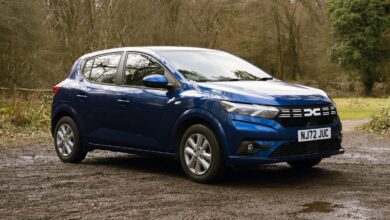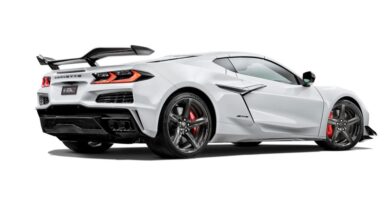2023 Kia Sorento GT-Line V6 FWD review

The Kia Sorento is hot property these days.
Despite ongoing supply issues, Kia’s flagship SUV (for now) set an all-time sales monthly record in November 2022 with 1063 units, with 7889 registrations recorded for the calendar year – an increase of 53.9 per cent.
Kia has been reporting lengthy wait lists on high-spec variants for yonks, and the Sorento is becoming an increasingly common sight on Australian roads.
It remains one of the benchmarks in the unibody large SUV segment, combining space, luxury and overall driving refinement for an attainable price point, even at the top end.
Here on test we have the 2023 Kia Sorento GT-Line V6 FWD, which combines the flagship interior trim with the less popular front-driven V6 petrol drivetrain.
With the Sorento Hybrid and Plug-in Hybrid unavailable at this point, and the Diesel AWD version commanding a hefty $3000 premium, the car you see here is the cheapest and only petrol option version on sale with all the trimmings.
The company recently told us supply had improved to the end of last year, and with Sorento sales up 109.5 per cent year to date as of May 31, it appears that’s still the case into 2023.
However, with a tecchy facelifted model due here before the end of the year, should you place an order on the current car or should you hold tight for the update?
How much does the Kia Sorento GT-Line V6 FWD cost?
The Sorento GT-Line V6 FWD on test retails for $62,070 before on-road costs, or $65,990 drive-away according to the brand’s online configurator, based on a Melbourne postcode.
That’s a hefty $7220 more than the Sport+ grade just one rung down, but also $3000 more affordable than the Diesel AWD – which is the overwhelming favourite amongst Australian buyers.
Despite being the top-spec variant, the GT-Line is positioned against mid-spec versions of big-name rivals, like the Toyota Kluger GXL (from $60,640), Mazda CX-9 GT (from $64,700), and Hyundai Palisade Elite (from $65,900).
If you use the third row occasionally and are happy with something a bit smaller, options like the related Hyundai Santa Fe Highlander V6 FWD ($63,050), Skoda Kodiaq Sportline 4×4 ($59,990 D/A) and Volkswagen Tiguan Allspace 162TSI R-Line ($60,290) are solid alternatives.
Even after a couple of minor price rises, you can see why so many buyers love the top-spec Sorento – it’s excellent value for money.
2023 Kia Sorento pricing:
3.5 MPi V6 FWD
- Kia Sorento S V6 FWD: $47,650
- Kia Sorento Sport V6 FWD: $50,270 2022
- Kia Sorento Sport+ V6 FWD: $54,850
- Kia Sorento GT-Line V6 FWD: $62,070
2.2 CRDi AWD
- Kia Sorento S Diesel AWD: $50,650
- Kia Sorento Sport Diesel AWD: $53,270
- Kia Sorento Sport+ Diesel AWD: $57,850
- Kia Sorento GT-Line Diesel AWD: $65,070
1.6T T-GDi HEV / PHEV
- Kia Sorento GT-Line HEV FWD: $66,750
- Kia Sorento GT-Line HEV AWD: $69,750
- Kia Sorento GT-Line PHEV AWD: $80,330
Prices exclude on-road costs
What is the Kia Sorento GT-Line V6 FWD like on the inside?
Not much has changed since launch other than the new Kia logo, but it’s still a great place to sit.
Crisp displays, quilted nappa leather, and metal-like trim accents make the Sorento GT-Line feel like a more expensive vehicle than it is.
The front seats offer full electric adjustment as well as heating and ventilation, with the driver’s pew also offering memory.
Ahead of the driver is a smooth leather steering wheel which feels great in the hands, and behind it is a 12.3-inch digital instrument cluster – the GT-Line is the only grade without analogue dials.
The cluster is clean and offers attractive graphics, if a little lacking in customisation.
You can’t project maps into the cluster like Volkswagen Group alternatives, even if you can have turn-by-turn prompts show up if you use the embedded navigation routing.
It is augmented by a colour head-up display, and can tell you speed sign information, speed, or driver assistance information.
Comfort up front is excellent thanks to the supportive seats, which offer a wide range of adjustment – as does the manually-adjustable steering column.
The upright dashboard and boxy body lend an airy, spacious feel up front. A good mix of soft-touch and metallic-aping surfaces give of a luxury vibe, as do the chunky switches and controls – though the metal-look trim bits are plastic.
Atop the dashboard is a 10.25-inch touchscreen infotainment system which still looks fresh, and in typical Hyundai-Kia style has simple menus, attractive graphics and pretty snappy loading times.
Core features expected of modern cars like Apple CarPlay and Android Auto, DAB radio and satellite navigation are all present and work well, though the Sorento currently lacks a few bits increasingly common in 2023.
Smartphone mirroring is wired – though the facelift will change that – and the Sorento doesn’t offer Kia Connect online services like some other models in the range, which seems like a loss given its flagship status.
Again, the facelift will bring this added functionality, but it’s a shame Kia hasn’t been more willing to add these sorts of things as running changes.
Storage and practicality up front is pretty good too. There’s a lidded cubby at the base of the dashboard with a wireless phone charger as well as three USB-A outlets – one for Apple CarPlay/Android Auto, and two charging ports.
The cubby is so deep you can hide away the cables when you have your phone hardwired in for smartphone mirroring by closing the lid. Wireless functionality with the facelift will still be a welcome upgrade.
A pair of large, toothed cup holders sit in the centre console, backed by another slot for smaller items like keys and coins.
Under the padded, leatherette-lined front-centre armrest there’s a well-sized bin that can carry larger items. My main gripe is the skinny door bins, which can’t hold larger bottles.
The Sorento remains one of the segment benchmarks for second-row accommodation, with plenty of room for larger adults in head, leg, knee, and toe room.
Having the panoramic roof creates an airy and spacious feel, and lets in heaps of light. It doesn’t impede on the rear head room like you might find in some other vehicles.
Amenities like a fold-down centre armrest with cupholders, heated outboard seats, map pockets, ISOFIX and top-tether points, as well as a sliding bench all help the Sorento meet your family’s various needs.
Even better, the third row is accessed via a quick-release button on the outer seats, which remotely tumbles and slides the second-row pew out of the way – no need to yank the backrest and then slide the thing forward.
Once you’re back there, the Sorento offers good space for the class, but won’t be challenging a Palisade or Carnival anytime soon. ISOFIX anchors and cupholders feature back there, which is handy, as well as individual fan controls for the wall-mounted air vents.
Boot space is unchanged relative to the Sorento Diesel. Kia quotes 187L with the third row in place, 616L in five-seater configuration, and 2011L with just the first row seats up.
The Sorento range features a full-size alloy spare wheel underneath the rear, something that’s not a given these days.
What’s under the bonnet?
On test we have the 3.5-litre MPi naturally-aspirated V6 petrol engine, driving the front wheels only via an eight-speed automatic transmission.
Kia quotes outputs of 200kW (6300rpm) and 332Nm (5000rpm) from the naturally-aspirated six, which compares favourably to the diesel on power (148kW) but not quite on torque (440Nm).
Australian Sorentos (as well as related products) don’t offer all-wheel drive with the six-cylinder powertrain, apparently due to packaging difficulties when converting from left- to right-hand drive.
The V6 FWD variants quote combined fuel consumption of 9.7 litres per 100km (6.1L/100km for the diesel), and CO2 emissions of 222g per kilometre. All non-hybrid Sorento models feature a 67-litre fuel tank, with the V6 compatible with regular 91 RON unleaded.
Both the V6 FWD and Diesel AWD variants quote a braked towing capacity of 2000kg, with towball download of 200kg.
How does the Kia Sorento GT-Line V6 FWD drive?
If you can do without all-wheel drive, the Sorento V6 is a smooth operator.
The 3.5-litre V6 offers linear performance and is very happy to rev out to its sweet spot when you need it, given peak torque doesn’t come in until a lofty 5000rpm.
When you’re giving it the beans, the six-cylinder motor has a lovely, brassy note that’s well insulated to maintain refinement, but is also nice to hear compared to some of the buzzy or rattly sounds you hear in this class.
I also commend Kia’s calibration of the eight-speed automatic, which is responsive and intuitive at the same time. Sometimes I find the eight-speed DCT in the diesel can be a little elastic off the line and at low speeds; this has no such issues.
Kia also has a knack for nailing ride and handling tunes with its local team, and for the most part the Sorento GT-Line offers a ride that could challenge much more expensive metal in balancing comfort and dynamics.
While the 20-inch wheels on the GT-Line V6 and Diesel can get a touch jittery over sharper and high-frequency imperfections around the city, the Sorento is very composed with an almost European tautness that rarely if ever crashes or jars.
Even better, once you hit the open road it settles nicely, feeling beautifully planted and secure at 110km/h on undulating country highways.
The steering strikes a balance and is light enough to easily manoeuvre this family bus in tight urban areas, while also having enough weight and feedback to confidently keep you on the straight and narrow or corner confidently.
With that said, the lack of all-wheel drive means you’re best to drive the Sorento in a more relaxed and measured manner to avoid lighting up the front wheels, especially in adverse weather.
If you want a petrol Sorento with all-wheel drive, you’ll have to put an expression of interest down for the Hybrid or Plug-in Hybrid, which are significantly more expensive.
Overall refinement at speed is pretty good for the class, though there’s a bit more tyre roar off the GT-Line’s 20-inch rims than would be expected of a premium vehicle, something that separates this Kia from the likes of the Audi Q7 and Volvo XC90 – though it’s far from unrefined against some rivals.
Wind noise is pretty well suppressed despite the larger wing mirrors, but you can get some whistle over the sunroof. Close the shade though and it’s a nice place to spend time on family road trips.
Kia’s driver assistance systems are pretty well sorted, with user-friendly and intuitive adaptive cruise control and lane-keep assist features, and having Lane Following Assist activated essentially semi-autonomous driving – though some may not like the over-assisted feel of the vehicle keeping itself centred in the lane.
The Blind Spot View Monitor cameras exclusive to the GT-Line give you an extra degree of visibility, particularly when negotiating tight gaps in traffic, complemented by the usual blind-spot and rear cross-traffic assists that will apply corrective steering or brake respectively to keep you out of harm’s way.
Just as handy is the surround camera system with 3D View, which makes parking this 4810mm long and 1900mm wide SUV so much easier when you’re squeezing into tight car parks.
What do you get?
Sorento S highlights:
- 17-inch alloys with full-size spare
- 8.0-inch touchscreen
- Apple CarPlay, Android Auto (wireless)
- Autonomous emergency braking (AEB)
- Pedestrian, Cyclist detection
- Junction Assist
- Blind-spot assist
- Rear cross-traffic assist
- Multi Collision Brake
- LED headlights (reflector-type)
- LED fog lights
- Front-centre airbag
Sorento Sport adds:
- 18-inch machine-finish alloy wheels with full-size spare
- 10.25-inch touchscreen
- Satellite navigation incl. 10 years map updates
- Dual-zone climate control
- Auto defogger
- Tyre pressure monitoring
- 10-way power adjustable driver’s seat incl. 2-way lumbar
Sorento Sport+ adds:
- 19-inch alloys with full-size spare
- Smart key with push-button start
- Remote engine start
- Electric tailgate with height adjustment
- Leather-appointed seats (black)
- Heated front seats
- Heated steering wheel
- 2 x USB charging ports (rear seat)
- LED tail lights
Sorento GT-Line adds:
- 20-inch dark chrome alloys with full-size spare (V6, Diesel)
- 19-inch alloys with full-size spare (HEV + PHEV)
- 12.3-inch digital instrument cluster
- Blind Spot View Monitor
- 8.0-inch head-up display
- 12-speaker Bose premium sound system
- Wireless phone charger
- Panoramic sunroof
- Interior ambient lighting
- Rear occupant alert
- Quilted Nappa leather-appointed seats (Black)
- 14-way power driver’s seat adjustment
- 10-way power front passenger’s seat adjustment
- Heated/ventilated front seats
- Heated rear seats
- Sunshade blinds (2nd row)
- Remote Smart Parking Assist (V6, Diesel)
- Parking Collision Avoidance Assist
- 360-degree cameras
Is the Kia Sorento GT-Line V6 FWD safe?
The Kia Sorento wears a five-star ANCAP safety rating based on tests conducted by Euro NCAP in 2020. All variants are now covered by this rating, including petrol, diesel, hybrid, and plug-in hybrid versions.
Category scores include 82 per cent for adult occupant protection, 85 per cent for child occupant protection, 63 per cent for vulnerable road users protection and 89 per cent for safety assist.
A key reason for the lower adult occupant score was protection of the driver’s chest and upper legs in the 50km/h frontal offset test, which was rated Weak. Meanwhile, lower-leg protection was deemed Marginal for the driver, as was protection of the front passenger’s upper legs.
Standard safety equipment includes:
- 7 airbags incl. front-centre
- Adaptive cruise control incl. stop/go
- Autonomous Emergency Braking (AEB)
- Pedestrian, Cyclist detection
- Junction Assist
- Blind-spot assist
- Driver attention alert
- Lane Following Assist (centring)
- Lane keep assist
- Multi Collision Brake
- Parking sensors front, rear
- Rear cross-traffic assist
- Reversing camera
- Safe exit warning
Sorento GT-Line adds:
- Blind Spot View Monitor
- Parking Collision Avoidance Assist
- Surround cameras incl. 3D View
How much does the Kia Sorento GT-Line V6 FWD cost to run?
Kia offers a seven-year, unlimited-kilometre warranty across its range. Owners who service their cars within the dealer network also get eight years of free roadside assist.
Maintenance is required every 12 months or 15,000 kilometres – whichever comes first.
The first seven years of servicing will set you back $345, $540, $419, $733, $388, $665 and $412 for a total of $3502 for the first seven years or 105,000 kilometres.
Perhaps a more relevant figure is the first five years of ownership (or 75,000km), which comes in at $2425. It’s not the priciest vehicle to maintain in the segment, but when Toyota charges $265 per service of a Kluger 2.4T 2WD for the same period ($1325), the Kia suddenly looks a little expensive.
As for real-world fuel consumption, we saw an indicated average of 9.5L/100km, which is actually better than the official claim. With that said, while I did a few days of peak-hour commuting and urban errands, I did a decent stint on the Hume as well.
For reference, the urban cycle fuel claim is 7.5L/100km for the V6.
CarExpert’s Take on the Kia Sorento GT-Line V6 FWD
Three years on, it’s still plain to see why the Sorento – particularly the GT-Line – has proven so popular with Australian families.
It has a tough design language reminiscent of Land Rovers and big American SUVs, blended with sleek proportions and an upmarket interior that offers features and technology usually reserved for the luxury class – all for similar money to what you’ll be paying in a mid-spec Toyota Kluger or Mazda CX-9.
The V6 petrol engine wouldn’t be my pick, but it’s a smooth unit that offers decent economy in mixed driving. For me, the Hybrid FWD makes the most sense if you’re doing mostly urban duties, but it’s currently not available to order and also will impose a $4700 premium.
All told the top-spec Sorento offers more space than the related Hyundai Santa Fe for less money, and a nicer interior than even a top-spec Toyota Kluger which is substantially dearer. The Mazda CX-9 shapes as a worthy adversary, but even the GT FWD version is more expensive than this Kia, and it feels more dated (a posher CX-90 is on the way).
If you’re looking right now, the Sorento is a top pick in this very competitive segment. The in-demand Diesel AWD is the better drivetrain choice, especially in the wake of the HEV and PHEV being taken off sale temporarily.
Arguably or test vehicle’s biggest issue is its successor, which is due to be revealed imminently ahead of an Australian market launch during the fourth quarter of 2023.
The facelifted Sorento will offer a refreshed design inside and out reminiscent of the upcoming EV9 all-electric flagship, and likely bring new, larger displays with connected services and wireless smartphone mirroring to go with the next-generation interface.
If you can’t wait much longer, the current model is a fine family chariot. Should you be able to hold off for a few more months, the updated one should reassert itself as the segment benchmark.
Click the images for the full gallery
MORE: Everything Kia Sorento
